How Climate Change Turned This Moroccan Village Into a Ghost Town
A Moroccan journalist returns to the oasis community where he grew up—parts of which are now abandoned by the effects of climate change.
Khalid Bencherif
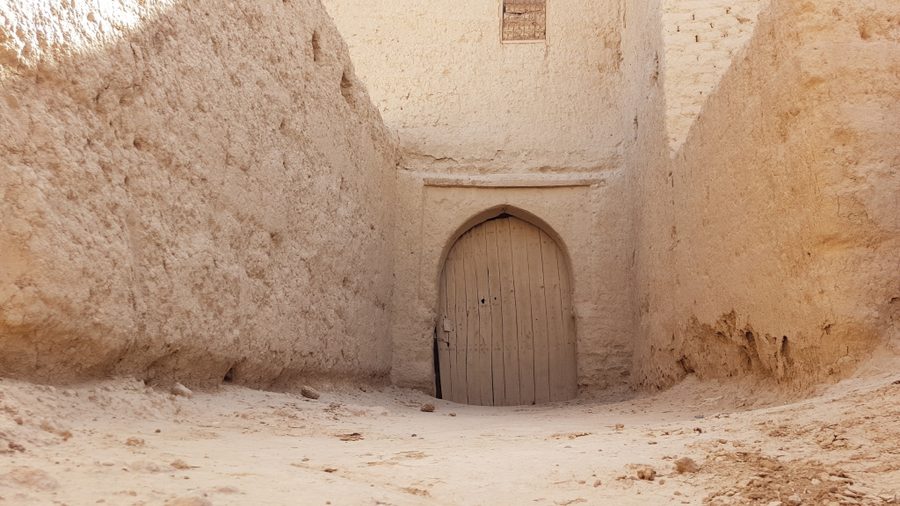
I still remember the day I visited the Moroccan city of Marrakesh in 2007. I was 16. It was my first visit to the city and the first time I had travelled outside of the region where I lived — an oasis region in the southeast known as Tafilalet.
I met my father waiting for me at the entrance of a noisy building workshop, a yellow helmet on his head, in blue workwear and with a hint of sadness behind his sympathetic smile — something so strange to me. He took my hand and escorted me into the workshop, and we walked into the yard amid scattered crowds of workers. Half-buildings stood on the sides of the square with piles of stone, cement and iron covering their sides; the roar of giant machines of every kind resounded, and big swear words flew.
We came to a shantytown inside the construction site where the workers lived. We went into my father’s residence through a narrow corridor separating the shanty blocks, with a dim light barely illuminating the road. Unpleasant smells intertwined and loud folk music came from some of the dwellings. The place was chaotic.
We arrived and my father opened the door and entered. It wasn’t a real home, just a 30-square-foot tin room. In the middle was a table with a few worn-out utensils. Untidy clothes were attached to a clip on the door. On the right was a wooden bed beside a fan trying in vain to dissipate the heat.
I sat on a rickety sofa in the corner, looking at the misery around me. My father offered me some olive oil and tea and asked me to stay there while he finished work.
I had never felt so lonely and alienated. I felt as though my breath was choking inside that tin can, and I thought to myself: Why did my father leave the warmth of the house and our spacious fields in the village, and travel thousands of miles to live in this cramped, miserable place, separated from his family and children for so many months? And how did my father transform overnight from a farmer who tends the palm trees and plows the field to a construction worker carrying iron and cement on his shoulders? And where did his gorgeous looks disappear to?
The road to Tafilalet
On August 1, I took a taxi to Tafilalet, my old home, to explore how climate change had led to mass rural migration in the region. As an environmental journalist, the story for me is even bigger. Since my family migrated from the village 10 years ago, I only visit my hometown occasionally.
It was not long before palm oases appeared on the side of the road, close to the city of Errachidia. From this point the extension of the Tafilalet oases begins, along 60 miles of road south to the town of Rissani and beyond. The area is home to about 1.5 million people, most of them in a kasbah -- a village similar to an earthen castle, enclosed by a wall containing simple adjoining houses of dry mud. Because of their ancient and impressive architecture, some of them (such as the Ksar of Ait-Ben-Haddou) are on the list of UNESCO World Heritage sites.
Even though these rural oases are dry and very hot, the livelihood of their inhabitants continues to be agricultural, benefiting from the Ziz River (which provides wells to water their crops) and from the abundance of the Hassan Al Dakhil dam in Errachidia (which transforms barren deserts into green oases with palm trees and plants, declaring the victory of life over death).
According to the Intergovernmental Panel on Climate Change, oases in hyper-arid climates are subject to water shortages because of climatic shifts, and many have been abandoned. Desertification has encroached on the oases and drought has intensified, and fires have destroyed many of them. This decline has prompted many residents to migrate to urban areas near and far.
The Es-Sfalat Tafilalet oasis, where I am heading, is one of these beautiful oases threatened with extinction, near the city of Rissani in southeast Morocco. It is home to villages whose residents lived a simple life, depending on grains and palm trees, before many of them fled.
After a few hours, I reached Rissani, deep in Tafilalet. I got out of the car, sun shining, and hurried my steps to meet Ibrahim Chafik in the café. Chafik is from the kasbah of Zaouiet Melaykhaf. He and his family left in 2008, the last of the migrants from his village, which was left empty.
Abandoned village
Chafik and I exchanged greetings and drank cups of tea. We recalled childhood memories in this area and how it never changed, as if time had stopped. Then we took a taxi to his hometown, passing the mausoleum of Moulay Ali Cherif and its beautiful architecture, reminding us that this place was the cradle of the Alawite State, a form of which continues to this day. After 15 minutes, we arrived in Zaouiet Melaykhaf in Es-Sfalat Tafilalet.
It was supper time and the village was plunging into pitch-black darkness. In the distance the glow of lights in neighboring villages emerged. Chafik used his phone to light our path. We reached his old house at the front of the village and he gestured to me, shining his phone on a small building at the house’s gate.
“Do you know what this is?” In a nostalgic tone, he explained, “It’s the water tank where I used to raise fish and look after the bee nests on the side.”
We entered the courtyard of the old house with its dilapidated walls and dusty floors. No one was taking care of it. When Chafik opened one of the rooms, the heat inside was unbearable. He carried a mat and some sheets, stored for such quick visits, and we climbed a broken ladder to the roof.
While Chafik was laying the sheets on the mat, a small scorpion rolled to the ground. “Beware, the place is full of insects since we abandoned it,” he said. He struck the scorpion with the bottom of his shoe and threw the body over the edge of the roof, then finished arranging the sheets as if nothing had happened. “Will we sleep here? The little scorpion must have a mother,” I joked.
On my back I looked up at the sky, crowded with luminous stars and the features of some glowing nebula. I had never seen the sky so clear anywhere I had visited, and I wondered how one could leave all this calm and beauty for the hustle and bustle of the city. The sight reminded me of my childhood, when I couldn’t sleep and would occupy myself by looking at the clear sky decorated with stars, listening to the sounds from afar of wolves and dogs. But this time there were no howls or barks.
In the morning we began our tour of the deserted village, ramshackle ruins and dilapidated houses everywhere, no sign of humans or animals. A ghost village. We walked among its paths (or what was left of them), treading carefully as if walking on eggshells. The walls of the earthen houses were about to fall and the roofs were fragile. It had become a ruin.
We stopped at the doorstep of one dilapidated house. The walls looked unstable, the windows were broken and on the floor were scattered fragments of the ceiling, fallen due to rain and time. The green paint of the walls was still holding on. In the dusty courtyard was a mat and pottery utensils, suggesting this house had once teemed with life and sheltered a family -- people Chafik knew perfectly well.
We left the abandoned house and passed another, which seemed more stable, with restorations. It was clear that its departed owners did not want it to collapse. Then we continued on.
Walking through the alleys of the empty village, signs of excavation at several sites caught my attention. Chafik explained: “This is the doing of treasure hunters and antiquities thieves,” a common phenomenon in Morocco that usually affects ancient places, exposing them to further damage.
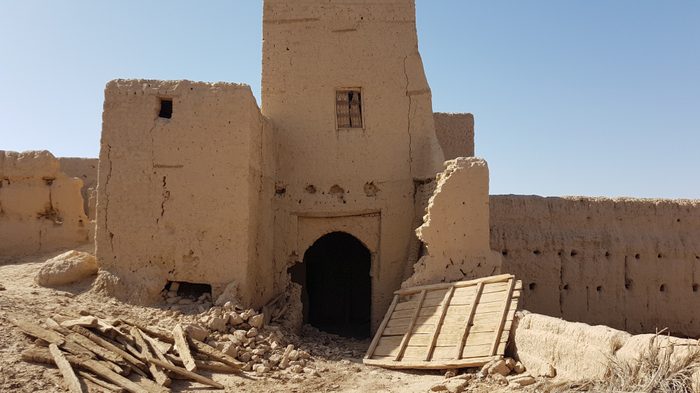
We went back to the old house to rest, the intense heat almost driving us out of our senses. I asked my companion: “Why did you abandon your village completely?”
Chafik took off his sun hat and leaned on a worn-out pillow. “The migration started in the 1990s. In 2000, 22 families were living in this village. Now, as you can see, there is no one left. My family was the last to leave. After the drought hit our land and the rivers dried up and the land was no longer suitable for cultivation, our livelihood was cut off, and people felt what they were doing was a waste of time. So they gathered their bags and left one by one until the village was completely empty.”
“The decision to migrate was not easy, and it came against our will,” Chafik continued. “Some families in this village left despite the lack of shelter for them in their new destination and resorted to renting. This shows the great desperation in the area, to the extent there was no longer any other solution than to leave. It was a necessity.”
Zaouiet Melaykhaf was not the only abandoned village in the Es-Sfalat Tafilalet region. There were also Zawiyat Raml and Tawghart. The rest of the villages had also witnessed mass migration to varying degrees.
It is not just one village, but the entire Tafilalet oasis region which has experienced intense rural migration during the past two decades.
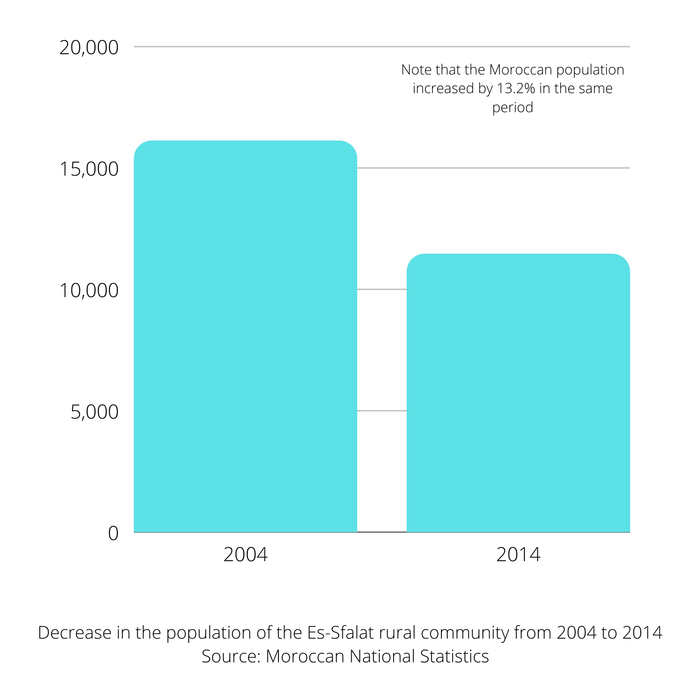
Dead valley
That evening we headed to the Ziz Valley. We walked around the village, where palm trees appeared from here and there, dried leaves hanging from some, as if dying. Then came the barren land behind the village, a white dirt land. The eye stretched along the flat ground, far to the horizon, where the curving slopes of distant mountains and the clear blue of the sky appeared, and the golden disc of the sun dipped behind the mountains, like a painting.
“Most of these spaces were green, full of palms and wheat fields, and you would see farmers toiling all day in their fields, sheep grazing in the pasture and children playing,” Chafik told me. But I saw no agricultural fields and no farmer working the land, even though harvest season had arrived.
We reached a place called Batha, which was completely dry. The valley ended with a huge earthen dam. Behind it were traces of a river, suggesting it had once been full to the point of overflowing onto the gigantic earthen embankment, the rest of it travelling to the emptiness far away. It is one of the two main rivers that supply the region with irrigation water, upon which Tafilalet oases depend for agricultural fields, through a series of water channels.
We went down to the valley and began to walk on the dry earth, bringing up more childhood memories. “You know I used to come here with the children of my village to swim under the heat,” I said. “There on the edge, I would jump headfirst into the water. I don’t remember ever touching its bottom, but now I’m walking on it!”
“I used to come here too, to catch some fish with a hook I made myself,” Chafik said. “From here I would bring the fish to that tank next to the house.”
Walking along the valley, our attention was drawn to the scattered homes of spiders, which had found no place to weave their webs other than on the valley floor, taking advantage of the cracks carved by drought, as if assured water would not flow into the valley again.
Although Morocco in general is suffering from the effects of drought, the oases of Tafilalet in particular are “under a serious scarcity of water resources due to climate change and human activities,” according to a study by a team of Moroccan researchers published in Water.
In addition to water scarcity, the researchers say the region also suffers from severe salinization in its aquifer, which explains the salt in the water wells in Tafilalet villages.
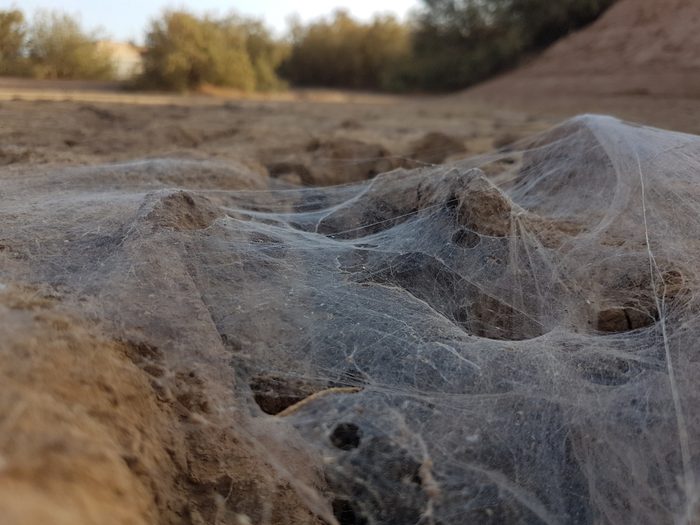
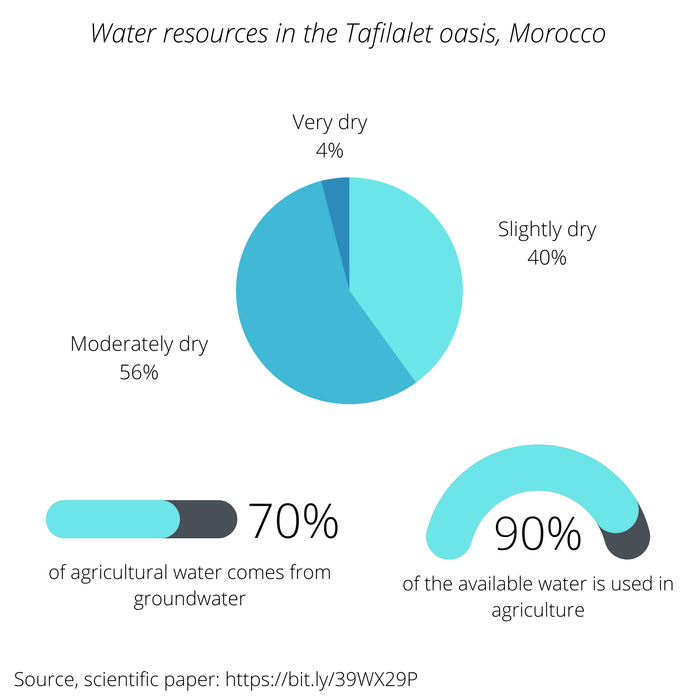
Migration from climate change
We returned to Chafik’s family house as night was falling and decided to go out for a night tour, roaming the desert surrounding the village in complete darkness, relying on the faint moonlight. Silence covered the place. I thought to myself that such a quiet and safe night tour would be impossible in the city.
We talked a little about the situation of the neighboring villages, and Chafik suggested visiting one of them. An earthen wall surrounded its entrance, like all the Tafilalet villages. We found a group of residents sleeping and chatting on mats, young and old telling jokes and stories while drinking cups of tea, enjoying a pleasant night breeze. It was a delicious experience I had not had for a while.
We greeted them and they welcomed us in to drink tea. We sat down and talked about the drought. They told me the inhabitants had always lived with drought and found ways to adapt to the harsh weather, but in the past two decades, the drought had become more and more extreme.
“For four years, we have not plowed out fields because we did not receive water from the streams, with an almost complete absence of rain,” one said.
This village had also experienced some migration. Residents estimate its population is about half that of the 1990s, and many still hoped the village would fill again. “These kasbah have known similar mass migrations due to drought and famine, but every time the land returns to life with rain and valleys, people come back to the area,” one person told me. No one thought this latest drought would be an exception.
But this drought is different this time, caused by climate changes which are getting worse. Morocco, and the Tafilalet oases in particular, are seriously threatened by climate change, according to the United Nations. When I looked at the climate data for the climatic zone that includes the Tafilalet region, on an interactive map designed by UN experts, it showed this region began to witness a qualitative change in climate at the beginning of the 1990s. Temperatures have continued to increase and precipitation has continued to decrease, and this trend will continue throughout the coming decades. The escalating climate deterioration will likely be paralleled by increasing migration.
In this region, climate change has led to an increase in temperature, which increases the evaporation of surfaces water, decreases precipitation and reduces the amount of total water in this local water cycle. Overall, it has increased the pace and intensity of drought in Morocco in recent decades, and is expected to worsen with climate change, according to the World Bank.
In addition to the impact of climate change, Ahmed Chaoui, an activist concerned with water rights, believes “the deterioration of the regulatory status of water and the lack of awareness also contributed to the drying up of the Tafilalet oases.”
Chaoui told me over the phone: “The new and influential landowners take advantage of the lack of real supervision to implement the irrigation map, so they irrigate their lands without limits and sometimes without the right, while many farmers take advantage of the ease of digging wells thanks to technology, without the awareness that groundwater is limited. The result is devouring the water shares of Es-Sfalat Tafilalet from the Ziz River and the Hassan Addakhil dam, and depleting the water table in the entire region.”
As my father tells me, this region has had a semi-arid climate by its geographical nature for centuries, but had been worked through a complex network of waterways managed by a committee of observers according to area tradition.
Today, however, climate change, combined with the ease of digging wells with machines and a lack of efficient water regulation, has pushed drought to extremes, turning many oases into white, barren spaces, such as the Es-Sfalat Tafilalet oasis.
The Es-Sfalat Tafilalet area depended on simple subsistence agriculture, based on plowing grain and harvesting date palms. In the absence of precipitation, the drying up of rivers and the salinization of the limited groundwater, everything on this land dies. Crops and yields decrease and people’s livelihoods are cut off in this barren place, so a lot of people decide to leave.
Migration and marginalization
As we returned home through the dark, barren fields, I asked Chafik: “Do you think that drought alone caused the exodus?”
He replied, “The drought was probably the main factor for most families, but the region is also marginalized. Our fathers might want to stay because they feel alienated in the city, and if it wasn’t for the drought they wouldn’t leave.
“But for the young and the next generation, I think even if they had the opportunity to stay, they would leave. They discovered cities and the better economic opportunities and services there. They also started thinking about buying a house, a car and other things that their parents didn’t think about.”
I interrupted. “If the village becomes green again, will you return to live here?”
“I will not return as long as there is marginalization, and I do not think that people, especially young people, will return to the area unless they have better job opportunities, sanitation, services and infrastructure.”
The High Commission For Planning, a Moroccan governmental body, classifies the Tafilalet region as the poorest in Morocco. The region’s severely backward infrastructure and lack of public services and job opportunities are testimony to their bad performance. Many Tafilalet villages don’t even have a sewage system to this day. As well, it does not appear that the poor people of this region have received anything from the millions of dollars of the Green Scheme launched by the government to rehabilitate national agriculture.
I pondered Chafik’s words. Perhaps drought wasn’t the only culprit in the exodus from Tafilalet. After we got home and rested, I called Rachid Elazzouzi, a university research student in Rabat who is also a migrant from Es-Sfalat Tafilaletvillage, to discuss the matter.
I asked Elazzouzi why he left. “The migration began in my village in the 1990s, with the onset of an arid drought,” he said. “
Elazzouzi said his village was one of the first areas exposed to the effects of desertification. “The decision was easy, after it became clear that living there had become a torment that nobody could endure,” he said.
“Don’t you think people will return to the area if it goes back to its previous condition?” I asked.
“Perhaps in the 1990s drought was the only factor in the large migration from Tafilalet villages, but today I do not think young people will return to the region even if the drought disappears, after seeing with their own eyes the city’s psychological, social and economic potential — despite the risks — in terms of education, work, infrastructure and independence opportunities.”
This idea is confirmed by a field study showing migration expands the options available to young people. Those who participated expressed “a greater sense of independence, belonging and self-actualization.”
In recent years, the Moroccan government has made attempts to improve the situation in the villages of Es-Sfalat Tafilalet by restoring some kasbahs and extending paved roads to isolated villages, as well as providing school transportation to facilitate education for girls. But these steps seem to have come too late. Many residents have already left, and the attractions of migration for young people are stronger than those of staying.
Putting aside the impact of drought and the marginalization of the region, I also found the heat unbearably intense. Although I had grown up there, I could barely stay for a few days, during which we sweated all day. It only cooled a little at night, when we slept on the roof. This is reason enough for some people to leave, especially since the residents can’t afford air conditioning.
Regardless, the effect of climate change, drought, and arid and excessive heat is the first engine of migration in the future, according to the World Bank. This is especially the case for poor communities, which incur the largest losses due to environmental degradation, losing their life or livelihoods and sinking further into poverty.
Migration is a last resort for these rural poor, as a natural reaction to their miserable environmental, social and economic conditions. Desperate, they see no other way to survive and improve their lives than to risk migration. It usually begins with the departure of one, two or more people to work or study. After a while, the rest of their family follows when they have secured a place in the city — which opens up promising opportunities but also carries great risks, especially for the most vulnerable who lack capital, networks and marketable skills.
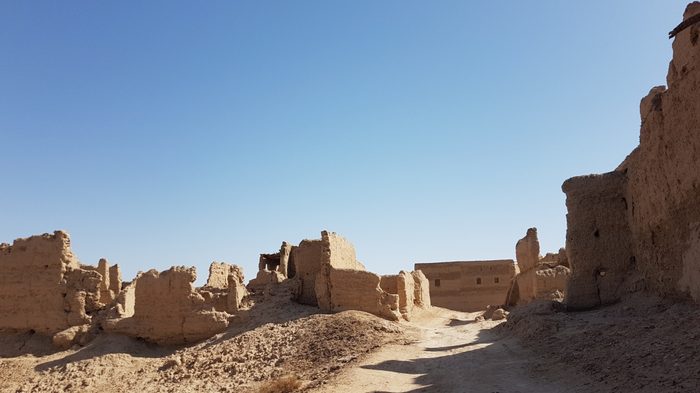
Environmental grief
The next morning, as we were walking around, a four-wheel-drive car arrived. Chafik seemed to know its passengers, a family with children. They exchanged warm greetings, then plunged into village news.
Later, Ibrahim confided that they were one of the migrant families from Fez visiting their old house — the one with the renovations.
Although the village was completely abandoned, some people — especially the elderly, like Chafik’s father — still visit and would stay if they thought they could. We had noticed one such person, a tired old man who could hardly walk. He had left his family in the city and returned to the village, staying there alone for months. I don’t know how he managed; he reminded me of the trout which does not rest until it returns home, upstream along rivers, to die peacefully at its birthplace.
It also reminded me of what I had read about rural migrants and my parents’ generation in particular, being alienated and depressed in the city, many feeling inferior, isolated and different in their new urban setting. They had left the environment in which they grew up and were not psychologically or socially equipped for the radical change. Climate change not only uproots the rural population, but also affects their mental health, causing what the scientific journal Nature calls “environmental grief,” a psychological reaction to environmental changes.
These rural migrants are also subjected to racism, harassment, fraud and exploitation by employers and some city residents. In addition to the awful working and housing conditions, the high cost of living and rent, they also face the pressures of their family in the village, impatiently waiting for them to send money.
Rapid rural migration, driven by climate change, also increases pressure on cities that are not equipped to receive large numbers of migrants in a short time. The World Bank warns that climate-related fast urbanization leads to high rates of unemployment, competition for services, and the exacerbation of poverty.
As the struggle over the few opportunities in the cities and the scarce resources in the villages intensifies, more violence and crime, more nepotism and corruption, should be expected.
Back on the tour, I saw a little bird writhing on the ground beside a palm tree, its wings failing. It seemed consumed by heat and thirst, so I poured some water on it, picked it up and put it in a shaded place, hoping it would find peace.
This environment is cruel to humans and animals alike. I was appalled by the decline of pigeons and other birds, which once filled the place with their song.
Losing cultural heritage
As we were leaving, we stopped at a sbala beside the village. This is a water tap covered with a cement dome, common in the Tafilalet basin. Each village has its sbala, the only source of drinking water. As we filled our bottles, a man arrived on a donkey, his face wrapped in gauze, carrying a bundle of plastic containers.
He was one of the nomads living deep in the arid desert. We helped him fill his plastic containers, and I asked with a kind of pity, “Do you have no water in your area?” He said in a low voice that held the fatigue of his long journey: “Our wells have dried up, so we come here to fetch fresh water.”
He finished filling up, then rode his donkey away into the barren land under the scorching sun, as if toward perdition.
I turned to Chafik and said: “You know, the great migration has not happened yet. It will happen when the taps run dry.” At least drinking water is still guaranteed in most areas of Tafilalet, but there were signs of thirst in some villages, especially with the limited fresh water suitable for drinking in this dry region.
The inhabitants here adapted for centuries to the semi-arid climate of the region. They built their homes from mud to insulate the heat, relied on drought-resistant palms and built very beautiful architectural canes. They turned the desert villages into green oases, and established symbiotic communities and distinctive cultures.
But it seems the region has finally exhausted its strength to adapt to this harsh geography. With drought induced by climate change and extreme poverty, over the past three decades people have been forced to migrate to the cities. It is a disappearance not only of the population, but of local cultural identity and their historical kasbah as a global Moroccan cultural heritage.
In the end, I came to understand my father’s story — why, overnight, he changed from a farmer to a construction worker. Drought induced by climate change, coupled with the marginalization of villages for decades, led him and tens of thousands of others to migrate to the city in search of a living — leaving behind land, home, children and family.
As I left the Es-Sfalat Tafilalet oasis, I thought about the irony. My father had worked hard to build hotels in Marrakesh for a few dollars a day, in inhumane conditions, for the welfare of those who caused his misery and displacement — for the tourists from rich countries that contribute the largest share to global warming, and for the welfare of Morocco’s wealthy, many of whom became rich from corruption and at the expense of the pain and poverty of village people.
Khalid Bencherif is a freelance journalist from Morocco, specializing in covering environmental, political, and social issues in North Africa and the Middle East. This story is supported by a Candid Foundation grant.




